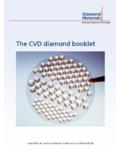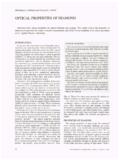Transcription of Structural and mechanical properties of Al–Si alloys ...
1 Materials Science and Engineering A 390 (2005) 63 69 Structural and mechanical properties of al si alloys obtainedby fast cooling of a levitated Nikanorova, , Volkova, Gurina, Burenkova, Derkachenkoa, Kardasheva, Regelb, WilcoxbaIoffe Physico-Technical Institute of Russian Academy of Sciences, Politekhnicheskaya Street, 26, Saint-Petersburg 194021, RussiabInternational Center for Gravity Materials Science and Applications, Potsdam, NY 13699-5814, USAR eceived 19 March 2004; received in revised form 5 July 2004; accepted 19 July 2004 AbstractData on the structure and mechanical properties of cast al si alloys in a wide compositional range from hypo-to high hyper-eutecticcomposition are scares. These properties depend on many factors during solidification of the alloys .
2 In the present work, samples wereobtained by rapid cooling of levitated melts of various compositions from to 35 Si. The measurements revealed linear concentrationdependences of density and Young s modulus. The average temperature coefficient of Young s modulus in the range from room temperatureto 500 C and the yield point for bending both had maxima at about 20 Si. The hysteresis of the temperature dependence of Young smodulus had a minimum at about 20 Si as well. Changing Young s modulus temperature coefficient and Young s modulus hysteresisas a function of the Si content are connected with the creation of the Guinier Preston zones. Values of the yield point are explained by theplasticity of components of the eutectic structure, primary crystals and grain boundaries.
3 The extrema of the concentration dependences ofthe mechanical properties occurred for the fine-grained structure arisen from coupled eutectic-like growth. Solidification at other conditionsled to formation of primary crystals of solid solution or primary Si crystals. 2004 Elsevier All rights :Aluminum silicon alloys ; Solidification; Alloy structure; mechanical properties1. IntroductionAl Si alloys are widely used in different fields of additives are usually used to modify industrial , much attention has been given to unmodified castalloys, especially to hypereutectic al si alloys . At the sametime, the structure and mechanical properties of hypereutec-tic unmodified cast alloys has been studied mainly for Sicontent up to 19 It is only known that increasing the Sicontent results in an increase of the strength of hypoeutecticalloys and a decrease of the strength of hypereutectic alloys [1,2].
4 In addition to chemical composition, the Structural andmechanical properties of alloys depend on many factors that Corresponding author. Tel.: +7 812 2479919; fax: +7 812 ( Nikanorov).act during solidification. Important factors are the structure ofthe melt, the crystallization rate, and the temperature gradi-ent at the liquid solid interface[1 5]. As a rule these factorsare varied simultaneously, giving rise to contradictory infor-mation on the structure and mechanical properties of Al Sialloys. Thus, for example, the yield stress 0,2was publishedto increase[2,4]or decrease[1]with increasing content ofSi. In order to investigate the influence of the Si content onstructure and mechanical properties , it is necessary to preventcontamination by impurities from the crucible and the envi-ronment, to maintain constant the superheating of the melt,to have a constant and rather high cooling rate, and effectivemixing of the molten aim of this work was to determine the influence ofSi content on the structure and mechanical properties of neareutectic and hypereutectic al si alloys with high Si contentobtained by fast $ see front matter 2004 Elsevier All rights Nikanorov et al.
5 / Materials Science and Engineering A 390 (2005) 63 69We used electromagnetic levitation of the melt for im-proved mixing and stirring of the liquid metal as well as toavoid contamination by impurities from the crucible. Themelt was cast in the metal mould. It was anticipated that dif-ference in the structure and properties of castings obtained atconstant rather rapid cooling of the melt would be determinedby the composition of the alloys effect of mechanical vibration and electromagneticstirring on the structure of solidified al si alloys was stud-ied in[6 8]. It was shown that mechanical vibration at vary-ing frequencies between 15 and Hz had reduced theshrinkage pipes and produced grain refinement but causedcoarsening in the eutectic silicon and of primary silicon ofAl wt% Si[6].
6 In[7,8]the possibility to refine Si parti-cles by crashing them during cavitation of bubbles in the meltunder electromagnetic field was investigated. In our work thesolidification of the liquid took place in the mould outside theregion of electromagnetic field so there were no cavitationduring crystallization. Earlier levitation melting was used in[9]to study the effect of undercooling on solidification ofAl 50 wt% Si hypereutectic Experimental procedureIn the present work, pure Al and semiconductorgrade n-type Si of 2000 cm specific resistivity were of al si alloys was achieved by applying an alter-nating inhomogeneous magnetic field produced by a levita-tion coil. The levitation coil was connected to a RF-generatorof 300 600 kHz, and 10 kW power was used to produce thelevitation field.
7 The coil and the sample were housed in avacuum chamber made of stainless steel and equipped withwindows to allow visual observation by a video camera andtemperature measurement by a pyrometer. The melting wascarried out at temperatures from 830 to 1040 C. The liquidmetal was cast into a massive Cu mould by decreasing the in-ductor voltage. Castings had the shape of 4 mm diameter rod50 mm in length. The melting and the casting were carriedout in a He atmosphere of 1 105Pa pressure. The alloys ofAl Si system of , 20, 25, 30, 35 Si were were cut with a diamond saw and polished formicrostructure characterization, which was performed on al-loys as-cast and after heating to 500 C during measurementof Young s modulus as a function of temperature. Samplesfor measurement of density and mechanical properties werecut by an electric spark density was measured by hydrostatic error of measurements of did not exceed Young smodulusEfrom room temperature to 500 C was determinedon rod samples of 10 30 mm in length by a resonant electro-static method[10]using longitudinal oscillations at a fre-quency of 100 140 kHz.
8 The error of measurements ofEwith an account of the dispersion for different samples wasabout 1%. The precision of measurements of temperature de-pendence ofEfor a separate sample was about 10 3%. PMThardness tester with indentation loads of 5 kg was used tomeasure Vickers hardness, HV. Deformation tests by three-point bending were performed with an Instron 1341 testingmachine at the constant sag rate of about m/s, the loadmeasurements being made at every second. The dimensionsof samples for mechanical tests were mm mm 20 ResultsOptical microscopy revealed a fine-grained structure forsamples prepared by quenching of liquid 1showsthe optical micrographs of al si alloys obtained by castingof levitated melts for (a) , (b) 20, (c) 25, (d) 30 and (e)35 Si.
9 In the hypoeutectic alloy (Fig. 1a) there is eutecticstructure with primary crystals of Si solid solution in Al. The20 Si alloy (Fig. 1b) has an anomalous finest-grain eu-tectic structure. There are star-shaped primary Si crystals onthe background of eutectic structure for the 25 Si com-position (Fig. 1c). The concentration and size of primary Sicrystals increase with increasing Si content (30 and 35 ).Fig. 2shows that the density of the alloys decreases almostlinearly with Si 3shows that Young s modulusEincreases with in-creasing Si content. It is noteworthy that alloys prepared byquenching of the levitated melt had higherEvalues than thoseobtained with conventional casting[5].The Vickers hardness was measured only for samples withSi content up to 15 The Vickers hardness of transversesections was slightly higher for 15 Si alloy (HV = 440 10 MPa) than for the sections of Si alloy (HV =430 20 MPa).
10 Fig. 4shows the temperature dependence of Young s mod-ulus of al si alloys with , 20, 25 and 30 Si as well asfor al si with added Sr. Note that thereis temperature hysteresis of Young s modulus for all alloysquenched from the levitated state except for the Al Sr alloy. The hysteresis depended on the 5shows the results of the bending test. Note that theloadPcorresponding to constant sagSof bending deforma-tion had a maximum near 20 wt% DiscussionIncreasing the Si content in al si alloys resulted in de-creasing of and increasing ofE. These dependencies wereclose to linear, indicating that quenching of the melt withvarious Si content took place under the same conditions. Thelinearity of concentration dependence of suggests that thesamples had few, if any, pores.





